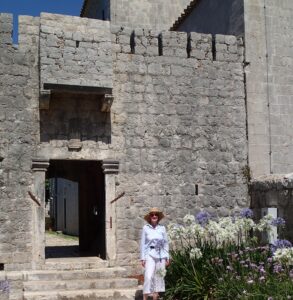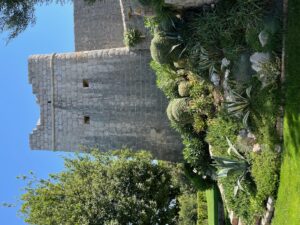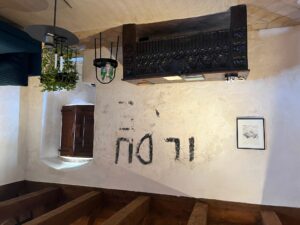As so often happens when you’re researching, I stumbled across Lopud 1483. Strange name for a monastery now turned event space and high end holiday let, but not when you discover that was the year the Franciscans started to build Gospa od Spilice, or Our Lady of the Cave.
 Perched on an outcrop overlooking the main harbour on the island of Lopud, just fifteen kilometres from Dubrovnik, the monastery and its fortifications have been a landmark for generations. After the 1820s it began to crumble, the monks having decamped back to the mainland leaving a local man to open the church for anyone who wanted to pray.
Perched on an outcrop overlooking the main harbour on the island of Lopud, just fifteen kilometres from Dubrovnik, the monastery and its fortifications have been a landmark for generations. After the 1820s it began to crumble, the monks having decamped back to the mainland leaving a local man to open the church for anyone who wanted to pray.
It was a tiny and often forgotten slice of the monastery’s history that fascinated me originally. I was researching what happened to Dubrovnik’s Jewish community during the Second World War and discovered that some of them had been interned on Lopud for a period of about six months. This was done under the strict instructions of the German occupiers, but the soldiers guarding them were Italians who up until that point had avoided imprisoning the Jews under their jurisdiction.
What fascinated me was exactly where on the island the unfortunate Jews had been interned. There didn’t seem to be very many buildings big enough, which left me thinking about the monastery. It might have been a ruin, but it had stout fortified outer walls and in many ways was an obvious choice. So imagine my surprise when, watching a documentary about the monastery’s restoration, I saw the words ‘il duce’ painted on a wall. Italian fascists had definitely been there.
 I really, really wanted to visit this beautiful place, as my characters do in the book I was writing and researching. They would have been there in 2010, quite early in the restoration programme, but I knew from experience that walking around the building and grounds would enable me to recreate it so much better for my readers.
I really, really wanted to visit this beautiful place, as my characters do in the book I was writing and researching. They would have been there in 2010, quite early in the restoration programme, but I knew from experience that walking around the building and grounds would enable me to recreate it so much better for my readers.
I knew I couldn’t afford to rent this iconic property (recent guests include the Beckham family), so I emailed the general manager with the dates of my Croatian trip and kept my fingers firmly crossed. The answer was yes; they had a small gap between rentals – basically a Sunday morning – and their security officer would show me around.
First let me say that Lopud 1483 is a little slice of heaven. Its restoration took the best part of twelve years, but in 2018 it opened its doors for cultural events and private rentals. The project was masterminded by Francesca Thyssen-Bornemizsa, and it now houses her family’s extensive collection of renaissance art, furniture and artefacts.
 Our guide was keen to tell us about the art, but also about the property’s history, including the physic garden and the monks’ pharmacy which have also been restored. To walk through the gardens is a wonderful sensory experience and I could have lingered there for hours, but of course I needed to find out about the Italian connection in World War Two.
Our guide was keen to tell us about the art, but also about the property’s history, including the physic garden and the monks’ pharmacy which have also been restored. To walk through the gardens is a wonderful sensory experience and I could have lingered there for hours, but of course I needed to find out about the Italian connection in World War Two.
Standing in the master bedroom looking at the fascist graffiti from eighty years before sent more than a shiver down my spine. The monastery had certainly been the Italians’ headquarters on the island but, as I discovered that day, not where the Jews had been interned. That dubious honour went to a hotel that had been built in the 1930s as a beacon of modernity, something I would never have found out had I not visited Lopud.
And I can always dream that the book, due out in summer 2023, is an international bestseller so I can afford to go back to Lopud 1493 and stay!
